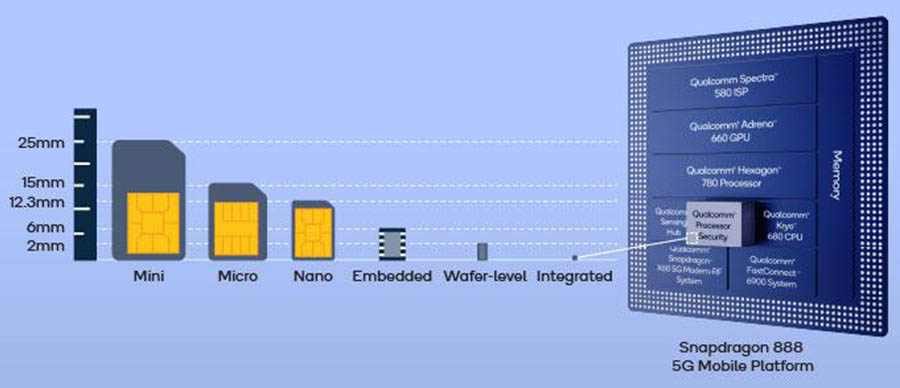
Back in 2020, Qualcomm unveiled the Snapdragon 888 as the first smartphone processor with Integrated Sim (iSIM). Now the chipmaker has demonstrated the technology in collaboration with Vodafone and Thales. In this article, we will be discussing the iSIM technology in more detail, including its advantages over traditional and eSIM.
What’s an Integrated Sim (iSIM)?
Let’s start with the basics. iSIM is the next evolution of SIM cards. Initially, we had physical cards which took a lot of real estate inside our phones. And even though the size of the cards kept reducing over the years, it was not enough.
Then came the eSIM. Contrary to the traditional sim cards, eSIM is permanently fixed into the phone. They are significantly smaller in comparison to physical SIM and even have better security. In addition, they also offer flexibility when it comes to switching carriers, international roaming, and sharing data plans across eSIM-enabled devices.

- Also Read:
eSIM vs iSIM
Integrated SIM (iSIM) is an advanced form of the eSIM. While eSIM exists as an independent chip inside your phone, Integrated SIM resides on your phone’s processor. ARM introduced the concept back in 2018 with IoT devices in mind. 2020’s Snapdragon 888 was the first processor to feature this new technology. Likewise, it is also in the latest Snapdragon 8 Gen 1.
As per ARM’s vision, iSIM is integrated into the System on Chip (Soc), alongside the cellular modem and hardware-based security. Thus, it has a smaller footprint, reduces power consumption, and brings down manufacturing costs.

iSim Proof of Concept
Qualcomm recently demonstrated a proof of concept of iSIM using a Samsung Galaxy Z Flip 3 5G. The test was held in Samsung’s R&D labs using Vodafone’s remote management platform. The phone featured Qualcomm’s Secure Processing Unit with Thales iSIM operating system.
Advantages of Integrated SIM (iSIM)
Based on the working demonstration, Qualcomm, Vodafone, and Thales have agreed upon the following benefits of iSIM.
- Makes room for other design and performance-based feature
- Provides flexibility of multiple accounts based on the existing eSIM platform
- Offers improved efficiency with less power
- Opens the way for mass IoT connectivity
Also Watch: Should you Buy a budget gaming laptop or a gaming PC?
















![Best Ultrabooks To Buy in Nepal 2024 [Updated] Best Ultrabook Laptops in Nepal 2023 - June Update](https://cdn.gadgetbytenepal.com/wp-content/uploads/2023/04/Best-Ultrabook-Laptops-in-Nepal-2023-June-Update.jpg)
![Best Gaming Laptops in Nepal 2024 [Updated] Best Gaming Laptops in Nepal 2023 - June Update](https://cdn.gadgetbytenepal.com/wp-content/uploads/2023/04/Best-Gaming-Laptops-in-Nepal-2023-June-Update.jpg)


![Best Mobile Phones Under Rs. 15,000 in Nepal [Updated] Best Phones Under 15000 in Nepal 2024 Budget Smartphones Cheap Affordable](https://cdn.gadgetbytenepal.com/wp-content/uploads/2024/03/Best-Phones-Under-15000-in-Nepal-2024.jpg)
![Best Mobile Phones Under Rs. 20,000 in Nepal [Updated] Best Mobile Phones Under NPR 20000 in Nepal 2023 Updated Samsung Xiaomi Redmi POCO Realme Narzo Benco](https://cdn.gadgetbytenepal.com/wp-content/uploads/2024/01/Best-Phones-Under-20000-in-Nepal-2024.jpg)
![Best Mobile Phones Under Rs. 30,000 in Nepal [Updated]](https://cdn.gadgetbytenepal.com/wp-content/uploads/2023/12/Best-Phones-Under-30000-in-Nepal-2024.jpg)
![Best Mobile Phones Under Rs. 40,000 in Nepal [Updated] Best Phones Under 40000 in Nepal 2024 Smartphones Mobile Midrange](https://cdn.gadgetbytenepal.com/wp-content/uploads/2024/02/Best-Phones-Under-40000-in-Nepal-2024.jpg)
![Best Mobile Phones Under Rs. 50,000 in Nepal [Updated] Best Phones Under 50000 in Nepal 2024 Smartphones Midrange](https://cdn.gadgetbytenepal.com/wp-content/uploads/2024/02/Best-Phones-Under-50000-in-Nepal-2024.jpg)
![Best Flagship Smartphones To Buy In Nepal [Updated] Best Smartphones in Nepal 2024 Flagship Premium Samsung Apple iPhone Xiaomi OnePlus Honor](https://cdn.gadgetbytenepal.com/wp-content/uploads/2023/09/Best-Smartphones-in-Nepal-2024.jpg)